.

On Wednesday, a solar eclipse gave people across a swath of Indonesia and the South Pacific the chance to see a generous 4 minutes and 9 seconds of totality: the awe-inspiring sight of the moon completely covering the sun, turning day into night and offering a rare glimpse of the corona, the gas swirling in the Sun’s outer atmosphere.
But in 1973, a small group of astronomers from around the globe had a secret weapon for seeing a longer eclipse than ever before: a prototype Concorde, capable of chasing the eclipse across the Earth at twice the speed of sound.
The future airliner—developed in a partnership between the French and British governments—had first flown in 1969 and was nearing the end of its successful test program. It had shown that supersonic passenger travel was very much possible, and proven easier to handle in the air and on the ground than had been theorized. Under the control and overall direction of French test pilot André Turcat, the French Concorde “001” prototype had set numerous speed and altitude records. An era of supersonic passenger flight was on the horizon, promising to cut trans-Atlantic jaunts to a breezy 3 and a half hours, less than half the time of a conventional jet.
As French and British aviation engineers readied their Concordes for passenger flight, the solar astronomy world was gearing up for its own milestone: the longest total solar eclipse of a lifetime, on June 30, 1973. The eclipse promised a luxurious view if you stood at the right place on the planet: a maximum of 7 minutes and 4 seconds as the moon passed over the Sahara Desert. It would be just 28 seconds short of the longest possible eclipse viewable from Earth; in the preceding several hundred years, there had only been one eclipse longer than this one, and there would not be a longer total solar eclipse until June 2150.
Independently of each other, astronomers in France and the UK saw a happy coincidence in the new aircraft and the upcoming eclipse: In Concorde, they could follow the shadow of the moon as it raced across the planet. In theory, a supersonic transport (SST) could give them over 70 minutes to watch the eclipse, ten times more observation time than they’d get on the ground, and high above any potential clouds and water vapor. Now they just had to get their hands on one.
“I don’t know if this kind of adventure would be possible today. I think now all the structures are way more organized and hierarchical.”
In London, British astrophysicist John Beckman had been using aircraft to do astronomy for years, despite being a nervous flyer himself. “I was working in a pioneer group of far infrared submillimeter physics,” he recalls. “At that time you could do very little work of any kind from the ground. You would have to go to very high mountains, or fly. My scientific curiosity allowed me to overcome my nerves.”
Beckman put in a request to use the British Concorde “002” prototype but was turned down, possibly because the UK test program was lagging behind the French. In May of 1972, just over a year before the celestial encounter, an astronomer from the Paris Observatory called Pierre Léna took his own proposal to French test pilot André Turcat personally. A scientifically-curious pilot, he’d given the young researcher an hour of his time. Over lunch at a restaurant inside Toulouse Airport, Léna sketched out his vision on the paper tablecloth.
“I don’t know if this kind of adventure would be possible today,” laughs Léna, now 78 but still an active member of the scientific community. “I think now all the structures are way more organized and hierarchical. I was lucky I got to do it, and of course I was young. In fact, I was very lucky people even took me seriously!”
The plan seemed deceptively simple. Closing in at maximum velocity, Concorde would swoop down from the north and intercept the shadow of the moon over northwest Africa. Traveling together at almost the same speed, Concorde would essentially race the solar eclipse across the surface of the planet, giving astronomers an unprecedented opportunity to study the various phenomena made possible by an eclipse: the ethereal solar corona, the effect of sunlight on the darkened atmosphere, and the brief red flash of the chromosphere, a narrow region around the sun that’s usually washed out by the much brighter photosphere.
Turcat was impressed. He pitched the idea to his bosses at Aérospatiale, who gave a tentative green light, and agreed to assume the cost of the mission. Turcat and chief navigation engineer Henri Perrier got to work on all the details, factoring in weather patterns and even ground temperatures in the places where Concorde could take off from, which would affect the fuel load. (The Concorde’s engines were optimized for the upper atmosphere, though this made them less efficient on the ground. Just taxiing for take-off, the Concorde burned more fuel than a 737 flying from London to Amsterdam, a fact which contributed to its eventual grounding.)
.
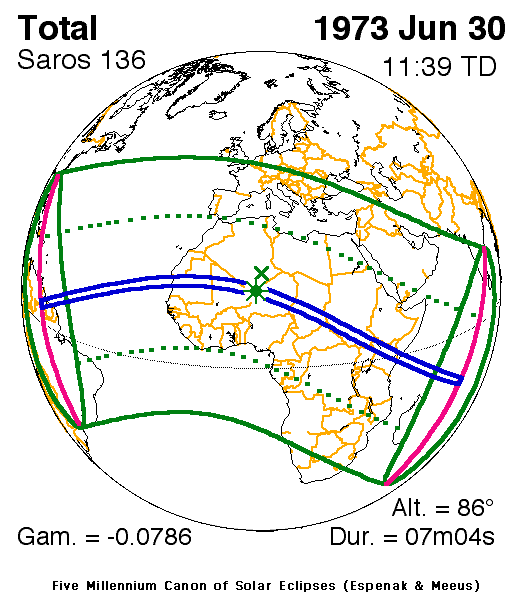
Eclipse map of June 30, 1973. Image: NASA
-
Léna and his colleagues began thinking of what experiments they would carry with them into the stratosphere and working out the details of actually intercepting the eclipse. After deciding on Gran Canaria as a good starting point, the team planned a route south and then east along the eclipse line. Turcat and Perrier looked into which runways in Africa would be able to handle the 200-foot long aircraft, which didn’t exactly stop on a dime. They pushed as far west as possible, to N’Djamena in Chad, with Kano in Nigeria as a back up. The actual rendezvous would take place over Mauritania, which agreed to close its airspace to commercial air traffic at midnight the night before.
“There was a lot to cover,” Léna recalls. First was the mechanical transformation of the plane. Occuring during the summer solstice and practically along the Tropic of Cancer, the eclipse would be at the zenith: directly above them. To view it properly, they would need to install portholes in the roof and design an apparatus to photograph through it.
The windows would have to resist the pressure difference between the cabin and the outside, as well as the high temperatures—around 100º C—felt on the outer surface of the fuselage in supersonic flight, due to friction. If the porthole were to blow out during flight, that wouldn't necessarily risk the safety of the flight, but it would require an emergency landing and an end to the experiment.
.
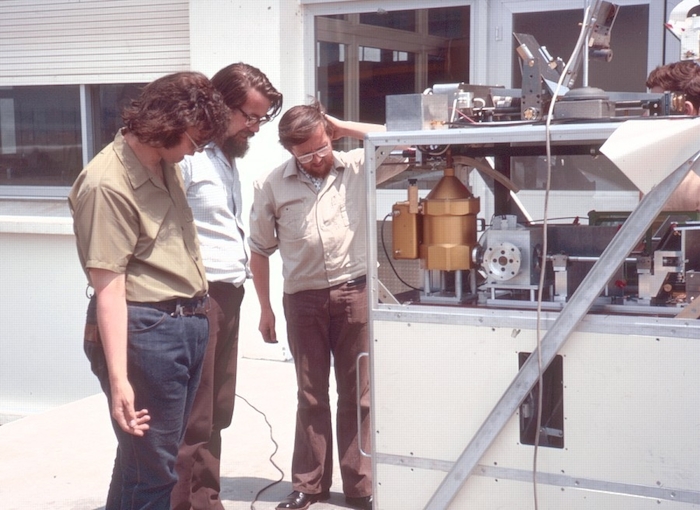
The Queen Mary College system being tested outside the Aerospatiale factory in Toulouse. Left-to-right: Jim Lesurf, Jim Hall (RSRE), and Tony Marston. Photo: Jim Lesurf
-
“As the research advanced and we got more excited, it became clear to us we couldn’t just do the flight without offering it to other scientists too. So we took the decision to use the Concorde’s maximum capacity and share it between five teams.” There would be scientists aboard from the French Institute of Astrophysics, Kitt Peak National Observatory, Los Alamos National Laboratory, Queen Mary University of London, and the University of Aberdeen. “So there were five different experiments, which had the advantage of spreading out the risk of failure. Each had a very different objective.”
When Beckman learned there was room onboard the special flight, “I was absolutely ecstatic,” he recalls. “And a bit worried.” For one thing, time was short. “I had the basic equipment, of course, which was a Michelson interferometer with a helium-cooled detector, but I didn’t have the infrastructure to link with Concorde and track the eclipse path. There was no time to automate it.” Instead, Beckman devised a way to track the eclipse manually, which would require “continuously turning a handle to keep the mirror aligned with one hand, while tilting it down into the observing hole with the other hand.”
At last, in February 1973, with just four months until the eclipse, the scientists received word that the mission was a go. The researchers rushed into final preparations. Besides the time constraints of the rapidly-approaching sun and moon, each experiment would have to cope with limitations imposed by the aircraft itself. Nothing could short-circuit—an onboard fire would be catastrophic—and everything had to be built to withstand the vibrations on takeoff: an afterburner-driven sprint that would accelerate Concorde to 250 miles-per-hour even before lift-off, pinning passengers firmly back against their seats. And, despite the aircraft's clean safety record at that point, in the back of the scientists' minds were legitimate concerns about flying in any experimental aircraft at supersonic speeds.
.
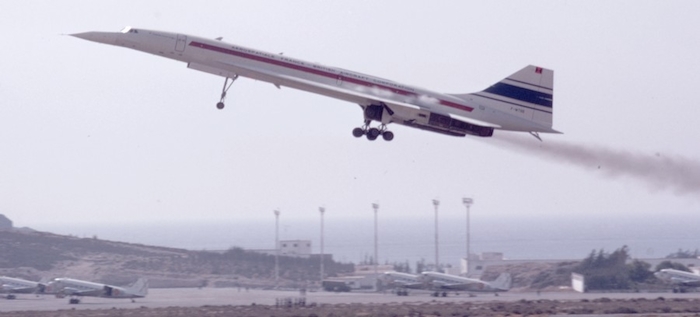
Concorde 001 taking off on its eclipse mission. Photo: Jim Lesurf
-
At precisely 10:08 am on the morning of June 30, the four twin-spool Olympus 593 engines under the Concorde’s sweeping white wings powered up to full afterburner and launched “001” down the runway of Gran Canaria's Las Palmas airport. Thousands of miles to the east, the shadow of the moon was already racing across the Atlantic at over 1,200 mph, tracing a path eastward from South America toward the African coast.
"There was no room for emotion; that came later."
Léna, Beckman, and the seven other astronomers aboard had no time to enjoy the joyride. “We were running through all the procedures in our minds,” recalls Léna, “and as soon as we got authorization from the cockpit to get out of our seats we got up and got to work. We had to double check the instruments, the pumps, the recorders… there was no room for emotion; that came later.”
Two minutes after take-off, the aircraft hit Mach 1, or about 707 mph at altitude, and headed southeast toward the moving shadow. Climbing up into the stratosphere at an altitude of 56,000 ft., Turcat pushed the aircraft to Mach 2.05, more than twice the speed of sound. Even after a couple of test flights the atmosphere on board was tense—the timing and the equipment had to work perfectly. Helped by Concorde’s two onboard inertial guidance systems, the crew guided the aircraft along the carefully-mapped trajectory and met the eclipse within 1 second accuracy of the planned rendezvous. The chase was on.
“Alone in the Mauritanian sky,” as a French film about the flight poetically put it, Concorde 001 hurtled east along the path of totality. With the eclipsed sun high over ahead, Turcat switched on the night-time navigation lights in the midday darkness. Paintings and stamps issued by various African countries would depict the epic, sci-fi sight, and Turcat would later deliberate about whether to file the flight as a day or night one.
"As the limb of the moon slowly occulted the solar disk, I saw the chromosphere, which flashed out in bright red alpha light.”
Under the four specially-made portholes and along some of the side-facing ones, Léna and Beckman, and others on board focused on the science. Léna and his team concentrated their efforts on detecting dust particles left over from comets in the solar halo, attempting to determine if there was a ring or sphere of them around the sun. Paul Wraith from Scotland used a side-porthole to watch the effect produced by the sudden darkness on oxygen atoms in the Earth’s atmosphere, while veteran American airborne eclipse chaser Donald Liebenberg looked up at the eclipse to measure pulsations in light intensity. From a porthole added to the roof of the plane, he observed, he said, how “the moon appeared to work as a slow camera shutter, slicing off only a tiny piece of the atmosphere each second.”
Beckman, meanwhile, was busy multitasking, with a tape recorder taped to his chest so he could make audio observations about the chromosphere. “Everybody was very concentrated on what they were doing,” he recalls, “but I did have time to glance out of the side window at one point and see the edge of the umbra, the penumbra and the daylight beyond. From the height we were at I could actually see the curvature of the earth, so it was pretty incredible. I was also able to gaze up at the corona and, as the limb of the moon slowly occulted the solar disk, I saw the chromosphere, which flashed out in bright red alpha light.”
.
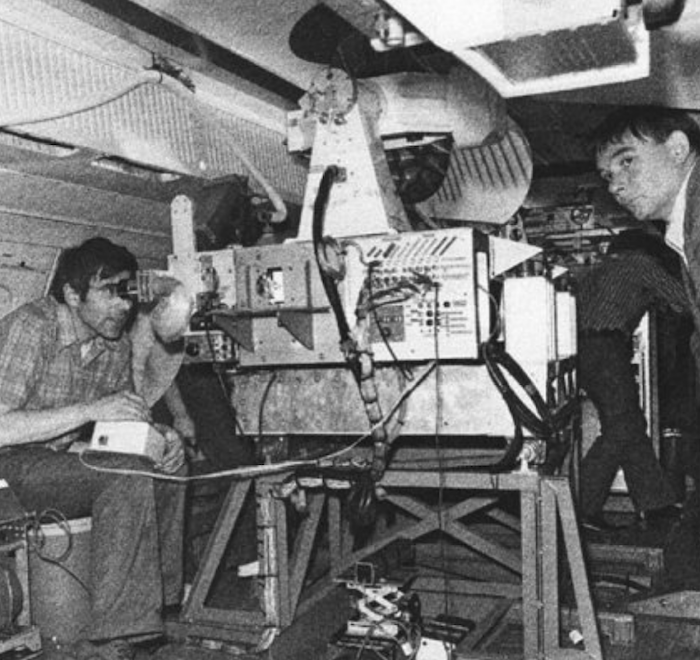
One of the specially-designed instruments for observing the composition of the sun's corona. Photo: Pierre Léna
-
The science and the Concorde could have kept going, but the landing site in Chad was coming up fast. Each team wrapped up their observations and managed to steal a few moments gazing out over the sands of the Sahara at a sight few get to witness. In all, the experimenters observed the totality of the eclipse for a record 74 minutes.
Turning south out of the darkness, Turcat began lining up for the approach. “I would have 10 tonnes of kerosene upon arrival,” he later wrote, giving him “forty minutes’ wait, and the right to a missed approach.” In any event, the aircraft landed smoothly, although Beckman remembers that “the aircraft was within meters of the end of the runway.”
“They all played their role in the normal progression of scientific knowledge, but there were no extraordinary results, it has to be said.”
The aircrew and the astronomers arrived to a surreal scene, having descended from the stratosphere at supersonic speed in one of the world’s most advanced aircraft only to emerge under the strange half-light of the African sun, still partially eclipsed. An attempted coup d’etat (possibly timed to coincide with the eclipse) meant that armored vehicles mingled with people on the street who were using smoky glass to gaze up at the sun.
In one flight, Concorde had given astronomers more eclipse observing time than all the previous expeditions last century—generating three articles in Nature and a wealth of new data. But today Léna, who has recently published a book in French and English about the experiment, Racing the Moon’s Shadow with Concorde 001, is modest about what it accomplished.
“The five experiments all succeeded, but none of them revolutionized our understanding of the corona,” he says in a disarmingly honest way about the flight’s immediate impact. “They all played their role in the normal progression of scientific knowledge, but there were no extraordinary results, it has to be said.”
For the 1999 solar eclipse over Europe, one French and two British Concordes briefly chased the moon’s shadow, but the only passengers on board were tourists. The tragic crash of Concorde flight 4590 shortly after takeoff from Paris on July 25, 2000, killing all 109 passengers and crew and 4 people on the ground, marked the beginning of the end for what Léna called the “great white bird.” Planned Concorde eclipse tours in 2001 were grounded, and in 2003 the final commercial Concorde flights touched down for the final time.
.
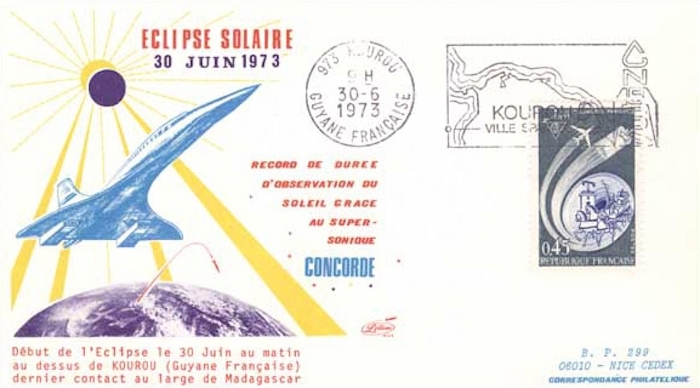
A 1973 French postcard commemorating the mission. Photo: E-space Lollini
-
NASA and Lockheed Martin have begun to explore designs for a new, quieter supersonic passenger jet (the Concorde's powerful supersonic booms limited its popularity). In England, a group called Club Concorde is trying to raise enough money to get a single Concorde flying again, possibly for the aircraft’s 50th anniversary in 2019.
Still, Léna doubts their incredible flight will ever be repeated. Today, space-based satellites that can watch the sun 24/7 and create permanent artificial eclipses have revolutionized our understanding of the nearest star to Earth—although observing eclipses on Earth is still useful for astronomy.
“At the time, our knowledge of the solar corona was very very limited,” explains Léna. “Today we have far less need for eclipse flights from a scientific point of view because we can put missions like SOHO in space, which is doing essentially what we were aboard Concorde. Our observation methods have changed a lot, so I doubt if today we’d redo a mission like that.”
It’s often said that scientific inquiry leads to innovation, but the Concorde experiment is a reminder that sometimes innovation offers wild, unexpected dividends to science. Today, the exact plane that chased the eclipse in 1973 sits as a permanent exhibit at Le Bourget Air and Space Museum, complete with the special roof portholes and the eclipse mission logo on its fuselage. Léna, John Beckman and other engineers and astronomers were present for the 2013 unveiling, along with the late pilot André Turcat, who passed away just last month.
“There’s no aircraft flying today that would let us do what we did, nothing that can fly that fast for that long," says Léna. "There are military jets that can fly faster, but not with the endurance of Concorde—and of course they couldn’t carry the instruments. Our record is safe for the foreseeable future.”
Quelle: Motherboard
4140 Views
